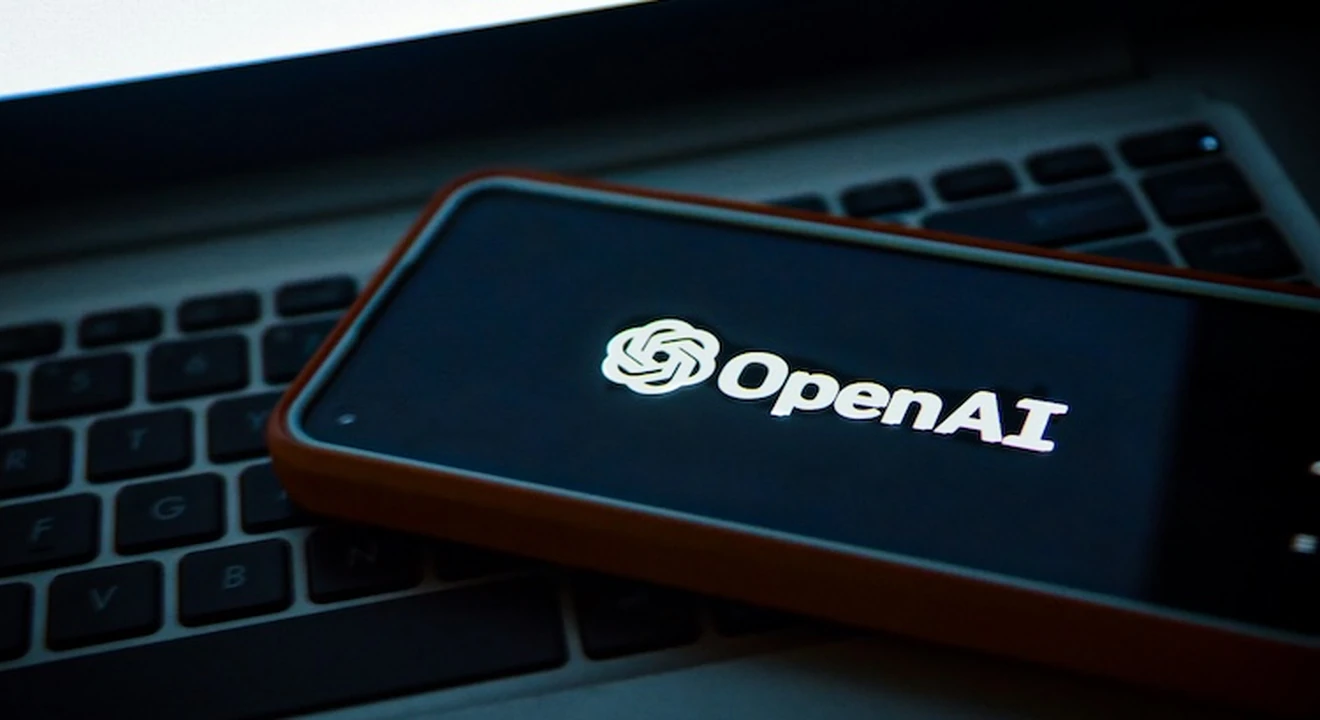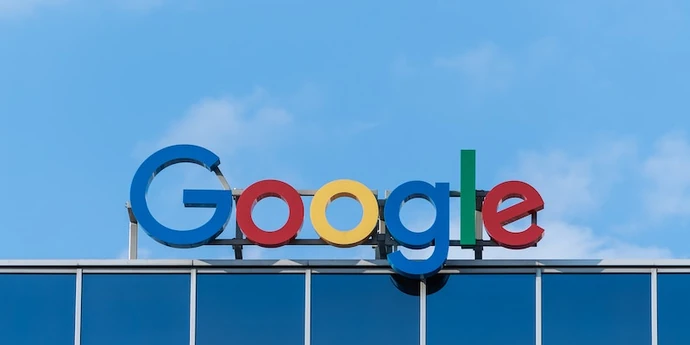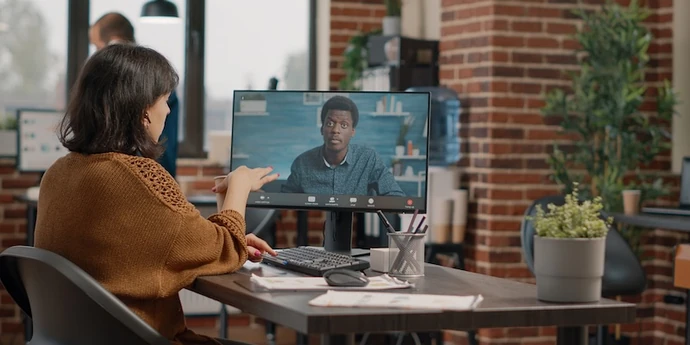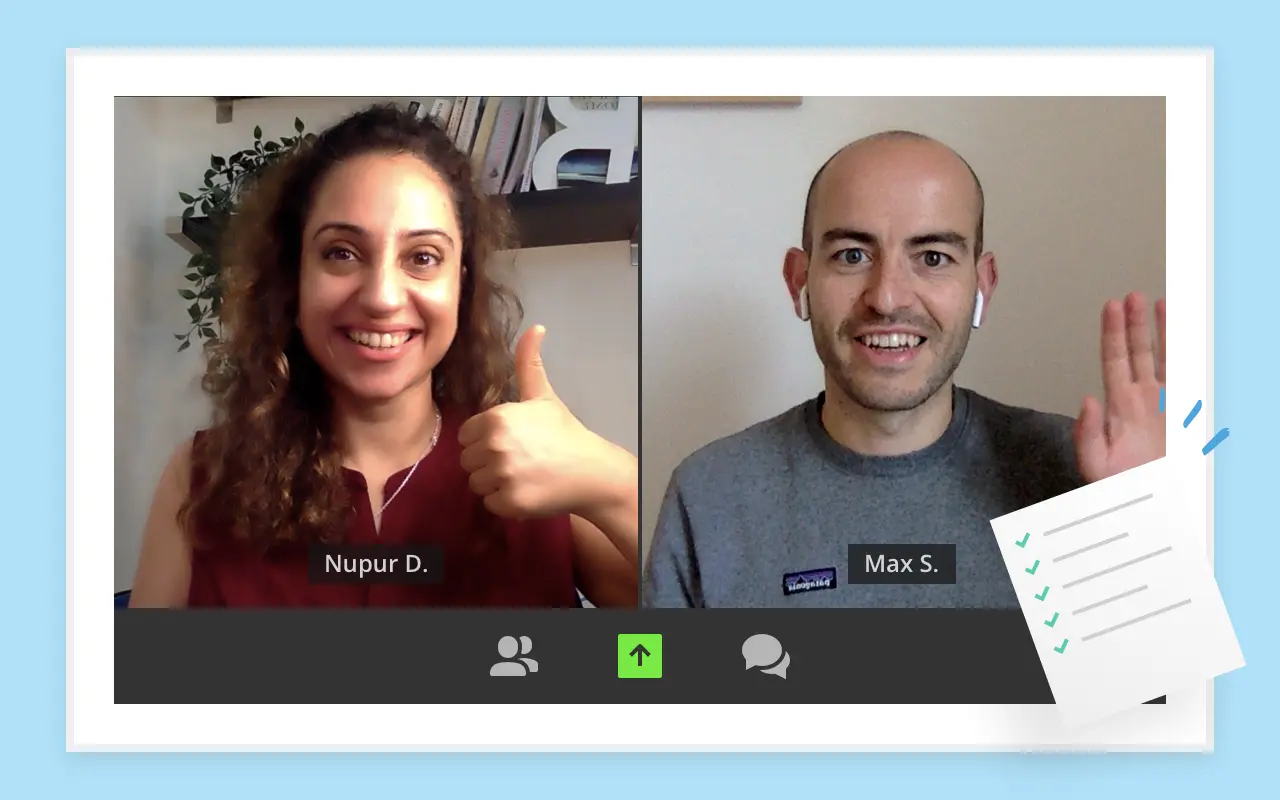In this guide, we’re going to cover everything you need to know to prepare for product manager (PM) interviews at OpenAI.
To put together this guide, we gathered insights from successful candidates we’ve worked with, real reports from OpenAI applicants on Glassdoor and other forums, and official OpenAI resources.
Part of interviewing at OpenAI involves demonstrating how your work aligns with the company’s stated mission of ensuring safe and beneficial AI. As a PM here, you’ll be expected not only to drive product strategy and execution, but also to navigate highly ambiguous environments and align your work with OpenAI’s broader mission.
Below you’ll find a detailed overview of the interview process, example questions, tips on how to answer, and a preparation plan.
Here’s an outline of everything we’ll cover:
1. OpenAI product manager role and salary ↑
1.1 What does an OpenAI product manager (PM) do?
As a product manager at OpenAI, you’ll be guiding the translation of breakthrough AI research into impactful products, whether that means building secure systems for public sector deployment or enabling broader enterprise adoption through tools like SSO or guardrails.
According to OpenAI’s career page job descriptions for PMs, OpenAI PMs often:
- Define strategy and product roadmaps for complex, safety-first initiatives, such as cross-agency ChatGPT deployments or scaled abuse detection systems.
- Lead features that require deep technical understanding and compliance, partnering with research, engineering, design, policy, and operations teams to launch responsible AI tools at scale.
- Operate in a fast-moving, ambiguous environment, driving product decisions that balance model trade-offs, safety guardrails, and mission alignment.
OpenAI PMs do more than just ship features. They’re also expected to weigh the broader ethical and societal implications of their decisions.
1.2 OpenAI product manager salary and compensation
OpenAI PMs make significantly more than other PMs in the US. Based on data from Levels.fyi, OpenAI product managers earn about 1.5–2x more than their peers at Meta or Google.
They have an average yearly total compensation of approximately $860K - $999K, with reported packages reaching up to $1.1M.
Compensation at OpenAI mainly depends on two key factors: role level and the unique equity structure (PPUs).
- Role level: Base salaries at OpenAI are competitive with other FAANG+ companies, but seniority and scope of responsibility drive increases in both cash and equity.
- Equity (PPUs): Instead of traditional stock, OpenAI uses Profit Participation Units (PPUs). These vest over four years (25% annually) and give employees a share in OpenAI’s capped-profit structure. This model creates far more upside than traditional equity at other companies.
To put this in perspective, the highest reported PM package at OpenAI reaches $1,100,750 per year, which is well beyond the senior PM bands at Google or Meta.
In short, OpenAI’s combination of competitive base salary and its unique equity structure makes it one of the most lucrative places for PMs in tech.
2. OpenAI PM interview process and timeline ↑
The OpenAI PM interview process usually takes 4–8 weeks and follows these main stages. While the exact details may vary depending on the role, here’s what you should expect:
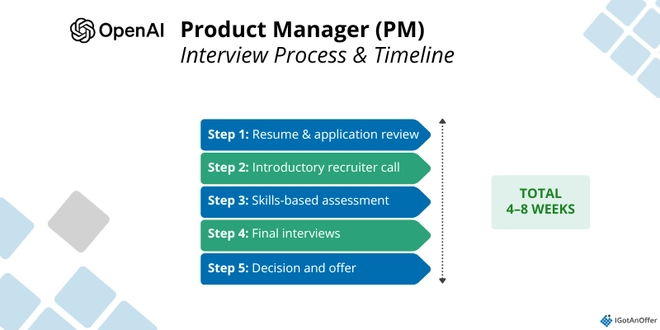
2.1 Resume and application review
First, recruiters will review your application and resume to see if your experience matches the role. This is the most competitive stage, so make sure your résumé highlights impact, leadership, and alignment with OpenAI’s mission.
2.2 Introductory recruiter call
If your application is strong, you’ll be invited to an initial call with a recruiter or hiring manager. Expect to answer questions about your background, motivations, and past product experience. This is also a good chance to show you’ve researched OpenAI’s mission and recent projects.
2.3 Skills-based assessment
Depending on the team, you may be asked to complete a take-home project, case study, or technical test. These assignments are designed to evaluate structured thinking, creativity, and communication. For PMs, assessments often focus on product strategy, analytical skills, or execution under ambiguity.
2.4 Final interviews
This stage usually consists of 4–6 interviews with OpenAI team members, spread over 1–2 days. Each interview is about an hour and covers:
Interviewers will test how you approach complex, ambiguous problems and evaluate your ability to communicate clearly while driving towards impact.
2.5 Decision and offer
After final interviews, feedback is compiled into a candidate packet for the hiring team to review. You can expect to hear back within about a week. At this stage, recruiters may also request references.
3. Example OpenAI product manager interview questions ↑
Let's dive in and look at the four types of interviews you can expect at OpenAI: behavioral, product sense, analytical & metrics, and culture fit.
We’ve analyzed candidate reports from Glassdoor, Blind, other forums and blogs, plus cross-referenced common PM interview frameworks.
While fewer examples are available compared to companies like Meta or Google, here are the main question categories and examples reported by candidates:
3.1 Behavioral questions ↑
Tech companies use behavioral interviews to assess job candidates based on their past experiences. These questions typically start with “Tell me about a time you…” and focus on soft skills such as leadership, communication, teamwork, problem-solving, etc.
Example behavioral questions asked in OpenAI product manager interviews:
- “What are your past experiences as a PM?”
- “Tell me about a product you previously launched.”
- “Tell me about a test you’ve done.”
- “If you had to do this project faster, what would you have done differently?”
- “How do you handle working in highly ambiguous environments?”
- “How do you process and grow from past experiences?” (Meta question)
- “How do you overcome difficult situations?”(Meta question)
- “How do you get stuff done and prioritize projects?” (Meta question)
For more guidance on behavioral questions, check out our guide to PM behavioral interviews.
3.2 Product sense questions ↑
Product sense questions should probably be your number one priority when preparing for your product manager interviews. These explore how you think about building and improving products at OpenAI, especially in fast-evolving AI spaces.
They get asked very frequently at most companies and are hard to crack if you're unprepared.
Example product sense questions asked in OpenAI product manager interviews:
- “What goal would you set for an AI-only social network that OpenAI is building?”
- “What industry could benefit most from enterprise ChatGPT?”
- “What’s your experience with AI-driven products?”
- “What’s your favorite product and how would you improve it?”
- “Design an umbrella for kids.”
For a more detailed look at how to answer product sense questions (including answer frameworks and more examples), see our specific guide to product sense interview questions.
3.3 Analytical & metrics questions ↑
Analysis interview questions test if candidates can perform data analysis, select key metrics that matter most to the success of a product, and problem-solve under uncertainty. There are two types of metric questions: metric definition questions and metric change questions.
Metric definition questions focus on your ability to define metrics that provide clarity on the health of a product or feature.
Metric change questions test if you know what to do when a key product metric (e.g., traffic, revenue, engagement, etc.) is going up or down for no apparent reason.
Example analytical & metrics questions asked in OpenAI product manager interviews:
- “Estimate the number of ChatGPT users worldwide.”
- “How would you measure success for OpenAI? What if instrumentation went down?”
- “What topline metric goal would you set for Airbnb?”
To dive deeper, see our guide on how to crack metrics questions in PM interviews.
3.4 Culture fit questions ↑
OpenAI puts strong emphasis on alignment with its mission of ensuring AI benefits all of humanity. Expect values-based questions.
Example cultural fit questions asked in OpenAI product manager interviews:
- “Why are you interested in working at OpenAI?” / “Why do you want to work at OpenAI?”
- “What do you like about OpenAI?”
- “What don’t you like about OpenAI?”
- “How do you align your work with the mission and values of OpenAI?”
Since there are fewer public examples of OpenAI PM questions than Meta or Google, candidates should also prepare for other general PM interview categories that haven’t been included, such as product strategy, estimation, prioritization & trade-offs, technical, etc. Practicing across categories will give you a structured foundation to handle even unexpected questions.
Click here to see more example questions, organized by category.
4. OpenAI product manager interview tips ↑
We’ve pulled together insights from OpenAI’s interview guide, blogs, and advice from experienced PMs like Mark, an ex-Meta and Google PM, who has run 100+ PM interviews.
Here’s how to approach your OpenAI PM interviews:
Tip 1. Align with OpenAI’s mission and values
OpenAI puts a huge emphasis on its mission to build safe AGI that benefits all of humanity. Expect interviewers to test whether you genuinely share that vision. Be ready to reference the OpenAI Charter and highlight how your past work connects to building ethical, impactful products.
"In product design questions, you’re going to literally want to cite the company’s mission back at them. If you’re interviewing remotely, write it on a post-it note and stick it on your laptop!" — Mark R., ex-Meta and Google PM
Tip 2. Be comfortable with ambiguity
Unlike companies with decades of playbooks, OpenAI PMs operate in uncharted product spaces. You’ll need to show you can take a vague, complex problem and break it down into a structured, logical approach.
"Product sense is really the most important interview at these companies. So if you’re looking for where to focus your preparation, really prioritize product sense questions." — Mark R., ex-Meta and Google PM
Tip 3. Show strong analytical and data-driven thinking
OpenAI prides itself on research-driven rigor. Expect estimation and metric-based questions, such as “How would you measure success for ChatGPT?” or “What would you do if instrumentation went down?”. The goal is less about the “right” answer and more about showing structured, data-informed thinking.
"You should be schooled on all the activation metrics - adoption, engagement, quality… etc. — there are dozens of metrics in there and you need to be solid on them all. Often, I think people don't think enough about retention and especially at Meta, that's a huge metric, and it's becoming more important at different companies too." — Mark R., ex-Meta and Google PM
Tip 4. Demonstrate technical curiosity
You don’t need to code, but OpenAI PMs work hand-in-hand with researchers and engineers. Expect to discuss how ML systems are deployed, what trade-offs exist in scaling APIs, or what risks need to be mitigated in new releases.
Tip 5. Communicate like a collaborator
Top companies like OpenAI want product managers who are excellent collaborators and can influence without authority. Show you can keep stakeholders aligned, explain trade-offs simply, and build trust across research and product teams.
"Don’t ask the interviewer, ‘Here’s my segmentation, what do you think?’ You need to be more confident. Say, ‘Here’s my segmentation, and I’m going to choose this segment because of X. Okay?’ Check in with the interviewer instead of trying to get them to show you the way." — Mark R., ex-Meta and Google PM
Tip 6. Emphasize adaptability and resilience
OpenAI looks for candidates who are mission-driven, thrive under uncertainty, and can stretch beyond their comfort zone. Use examples from your past that show adaptability, resilience, and a willingness to learn quickly.
5. Preparation plan ↑
We've coached more than 20,000 people for interviews since 2018. There are essentially three activities you can do to practice for interviews. Here’s what we've learned about each of them.
5.1 Practice by yourself
Practicing by yourself is the essential first step.
As you’ve probably noticed from the example questions above, you can’t become a PM at OpenAI without being familiar with the company’s products, research, and mission. You’ll therefore need to do some homework before your interviews.
Here are some resources to help you get started with this:
- The OpenAI Charter (mission and long-term principles)
- OpenAI’s blog (latest research and product updates, especially ChatGPT, GPT-4, and DALL·E)
- OpenAI research publications (to get a feel for the technical direction)
- Spinning Up in Deep RL (OpenAI’s own resource on reinforcement learning)
- Deep Learning Book by Ian Goodfellow (for foundational AI understanding)
-
Tech Philosophy and AI Opportunity by Stratechery (Ben Thompson)
As mentioned earlier, OpenAI interviews cover categories like behavioral, product sense/design, strategy, estimation, and metrics. Approaching each with a clear framework will help you build strong interview habits.
When it comes time for the actual interviews, those habits will reduce stress and help you deliver structured, confident answers.
If you're not sure where to start, you can start with these OpenAI and PM-specific interview guides.
OpenAI guides:
Product manager guides:
- Behavioral questions
- Product design questions
- Product improvement questions
- Favorite product question
- Strategy questions
- Estimation questions
- Metric questions
- Prioritization questions
- AI PM interview questions
Once you’re in command of the subject matter, practice answering questions out loud. But remember, practicing alone can’t simulate thinking on your feet under pressure or handling unexpected follow-ups.
That’s why many candidates also practice with peers.
5.2 Practice with peers
If you have friends or peers who can run mock interviews with you, it’s a great way to build confidence. Focus on:
- Product sense drills (e.g., design/improve an AI-driven product)
- Metrics/analysis (e.g., how to measure success for ChatGPT)
- Leadership/behavioral (practice STAR or SPSIL answers for ambiguity-heavy situations)
Peer practice is free, but it has limits:
- Feedback may not always be accurate
- Peers rarely have insider knowledge of OpenAI’s process
- No-shows can waste your time
Because of this, many candidates complement peer practice with expert feedback.
5.3 Practice with experienced PM interviewers
In our experience, practicing real interviews with experts makes the biggest difference, especially when the company is as unique as OpenAI.
Working with experienced PM interviewers can help you:
- Test yourself under real interview conditions
- Get accurate feedback from people who know what great answers look like
- Build confidence in your frameworks
- Learn how to tell the right stories more effectively
- Save time by focusing your prep on what matters most
Landing a job at a big tech company often results in a $50,000 per year or more increase in total compensation. In our experience, three or four coaching sessions worth ~$500 make a significant difference in your ability to land the job. That’s an ROI of 100x!






